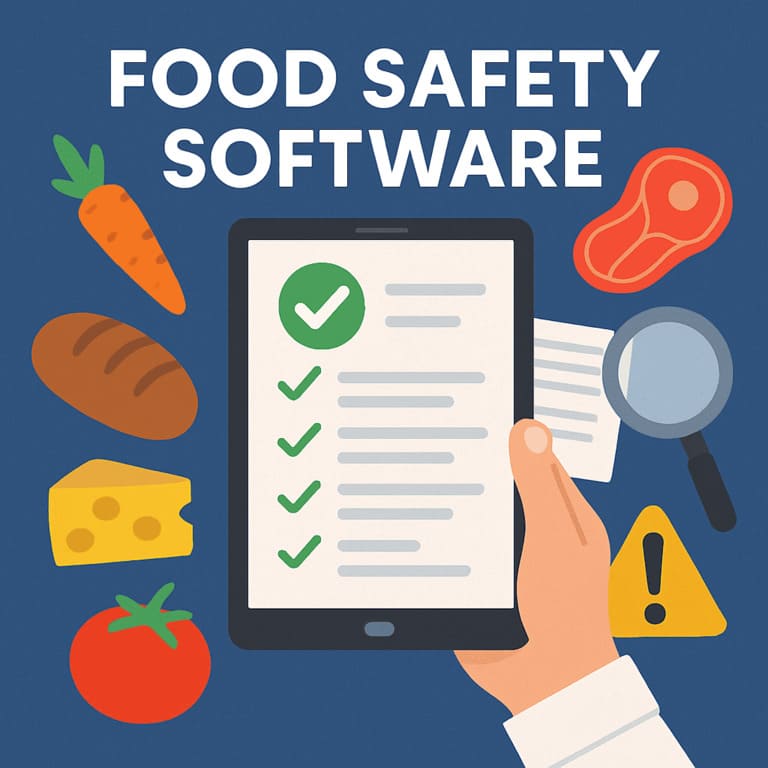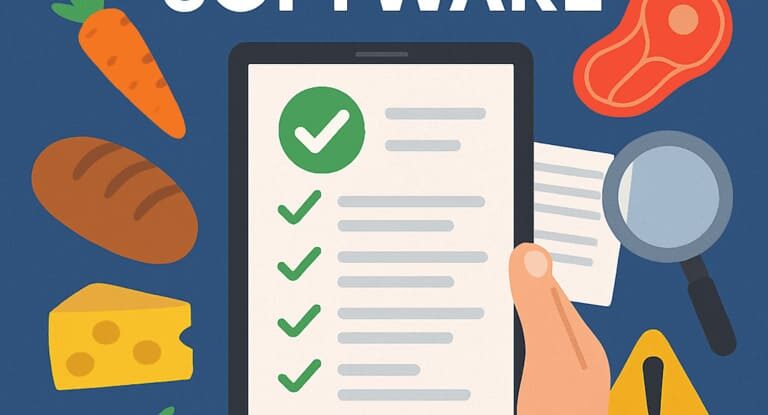Food Safety Software: Essential Solutions for Modern Food Business Compliance
How Food Safety Software Is Revolutionizing Industry Standards

Food safety is non-negotiable in today’s complex supply chain. Every year, millions fall ill from foodborne diseases that could have been prevented with proper systems in place. The answer for many leading companies? Food safety software.
This powerful technology is transforming how businesses maintain compliance, manage documentation, and ensure consumer safety.
The Growing Need for Digital Food Safety Solutions
The food industry faces unprecedented challenges. Regulations tighten yearly. Consumer expectations soar. Global supply chains grow more complex.
Paper-based systems can’t keep up.
Food safety software provides the answer—a centralized digital system that streamlines compliance and reduces risk.
But what exactly makes this technology essential?
Let’s explore why food businesses across the spectrum are making the switch to digital food safety management.
What Is Food Safety Software?
Food safety software is a specialized digital platform designed to help food businesses manage all aspects of their food safety programs. From hazard analysis to corrective actions, these systems digitize and centralize critical safety processes.
The best solutions offer:
– Real-time monitoring of critical control points
– Automated compliance documentation
– Instant access to records for audits
– Simplified reporting for regulatory requirements
– Supply chain visibility and traceability
– Temperature monitoring integration
Rather than scattered documents and manual processes, food safety software provides a single source of truth for all safety-related operations.
Beyond Basic Compliance
Modern food safety platforms go beyond checking regulatory boxes. They transform data into actionable insights that drive continuous improvement.
Advanced analytics identify trends before they become problems. Automated alerts notify teams instantly when parameters fall outside acceptable ranges. Mobile capabilities allow for documentation anywhere in the facility.
The difference is proactive management versus reactive crisis response.
ISF: Complete Guide to Importer Security Filing (10+2) Requirements
Key Benefits of Implementing Food Safety Software
1. Streamlined Regulatory Compliance
Staying compliant with FSMA, HACCP, SQF, BRC, and other regulatory frameworks requires meticulous documentation. Food safety software automates much of this process.
Pre-built templates align with specific regulations. Workflow automation ensures proper approval processes. Digital records are always audit-ready.
The result? Less time spent on paperwork and more time focused on actual food safety.
2. Enhanced Traceability
When contamination occurs, time is critical. Modern food safety platforms enable:
– Complete product traceability from farm to fork
– Rapid identification of affected batches
– Precise, targeted recalls when necessary
– Documentation of supplier compliance
This level of traceability isn’t just good practice—it’s increasingly mandated by regulations worldwide.
3. Cost Reduction
The ROI of food safety software extends beyond compliance:
– Reduced food waste through better monitoring
– Lower risk of costly recalls
– Decreased labor costs for documentation
– Minimized audit preparation time
– Protection of brand reputation
One major recall can cost millions. Prevention through systematic monitoring delivers significant savings.
4. Data-Driven Decision Making
Paper records sit in filing cabinets. Digital data drives improvement.
Modern food safety platforms transform collected data into actionable insights through:
– Customizable dashboards showing key metrics
– Trend analysis identifying recurring issues
– Predictive capabilities highlighting risk areas
– Performance benchmarking across facilities
This intelligence allows for continuous improvement rather than simply maintaining the status quo.
Choosing the Right Food Safety Software

Not all food safety software solutions offer equal value. When evaluating options, consider:
Scalability
Will the system grow with your business? Can it handle multiple facilities? Does it support different types of food operations?
The right software adapts to your needs rather than forcing your processes to adapt to it.
Integration Capabilities
Food safety doesn’t exist in isolation. Look for software that integrates with:
– Existing ERP systems
– Quality management software
– Environmental monitoring programs
– Laboratory information management systems (LIMS)
– Supply chain management platforms
Seamless data flow between systems eliminates redundant data entry and provides a more complete picture of operations.
Mobile Functionality
Modern food safety requires documentation where the action happens—on the production floor, in storage areas, at receiving docks.
Mobile capabilities allow team members to:
– Complete inspections on tablets or smartphones
– Upload photos of issues immediately
– Access procedures without returning to offices
– Sign off on corrective actions in real-time
This real-time documentation increases accuracy and efficiency.
Ease of Use
The best system provides no benefit if teams won’t use it. Intuitive interfaces, minimal training requirements, and user-friendly designs are essential for successful implementation.
Look for software designed with actual users—line workers, quality personnel, and managers—in mind.
AMS and US ACE: Complete Guide to Automated Manifest System and Customs Environment
Implementation Best Practices
Successful food safety software implementation requires more than just purchasing a system. Consider these critical steps:
1. Define clear objectives – What specific problems must the software solve?
2. Map existing processes – Understand current workflows before digitalizing them
3. Involve end-users early – Get input from the people who will use the system daily
4. Phase implementation – Start with core functions, then expand
5. Provide thorough training – Ensure all users understand the system’s capabilities
6. Review and optimize – Continually refine processes as you learn what works
The transition to digital food safety management represents significant change. Managing this change effectively determines success.
The Future of Food Safety Management
Food safety software continues to evolve rapidly. Emerging technologies shaping the future include:
– IoT sensors providing continuous environmental monitoring
– Blockchain enhancing supply chain transparency
– Artificial intelligence identifying patterns human observers might miss
– Predictive analytics forecasting potential issues before they occur
These innovations will further strengthen food safety programs, making them more proactive and precise.
The Complete Guide to ICS2 ENS Filing Requirements for Freight Forwarders
Conclusion: Digital Transformation as a Competitive Advantage
Food safety software has evolved from a nice-to-have convenience to an essential operational tool. Beyond meeting regulatory requirements, these systems deliver significant competitive advantages:
– Enhanced consumer confidence through demonstrated safety commitment
– Operational efficiencies reducing costs
– Data-driven insights driving continuous improvement
– Agility in responding to changing requirements
The question is no longer whether food businesses should implement food safety software, but which solution best meets their specific needs and how quickly they can deploy it.
In an industry where reputation hinges on consistent safety and quality, digital tools provide the systematic approach needed to thrive in an increasingly complex regulatory environment.
Food safety software isn’t just about compliance—it’s about building a foundation for sustainable growth and consumer trust in an increasingly competitive market.
FAQ
1. What is food safety software?
Answer:
Food safety software is a digital system designed to manage and automate food safety processes. It covers tasks like hazard analysis, compliance documentation, traceability, temperature monitoring, and audit readiness, offering a centralized platform for food businesses to ensure regulatory compliance and consumer safety.
2. Why is food safety software important in modern supply chains?
Answer:
With increasingly complex supply chains and stricter global regulations, food safety software helps companies stay compliant, reduce risks, and respond faster to potential contamination. It replaces outdated paper-based systems with real-time, data-driven tools that enhance safety and efficiency.
3. How does food safety software help with regulatory compliance?
Answer:
It automates documentation, provides pre-built templates aligned with standards like FSMA, HACCP, SQF, and BRC, and ensures that records are always audit-ready. This saves time and ensures that all safety actions are properly tracked and approved.
4. Can food safety software improve product traceability?
Answer:
Yes. The software offers end-to-end traceability, from farm to fork. It enables quick identification of affected batches during contamination events and facilitates efficient and targeted product recalls, which is critical for both compliance and brand protection.
5. What are the cost benefits of using food safety software?
Answer:
It reduces food waste through better monitoring, minimizes the risk of expensive recalls, lowers labor costs for documentation, and speeds up audit preparation. Ultimately, it helps protect brand reputation and offers a strong return on investment.
6. How does the software support data-driven decision-making?
Answer:
It collects and analyzes data to provide dashboards, trend reports, and predictive insights. This helps identify recurring issues, forecast potential risks, and continuously improve food safety performance across the organization.
7. What features should I look for in a food safety software solution?
Answer:
Key features include real-time monitoring, mobile functionality, integration with ERP or supply chain systems, scalability, user-friendly interfaces, and strong analytics capabilities. The software should adapt to your business, not the other way around.
8. Can the software be used across multiple facilities or sites?
Answer:
Yes. Many leading solutions are scalable and support multi-site operations. This allows companies to manage food safety programs consistently across different production or storage locations while maintaining centralized oversight.
9. How does mobile functionality enhance food safety?
Answer:
With mobile access, staff can perform inspections, upload photos, and document issues directly on the production floor using smartphones or tablets. This increases efficiency, reduces paperwork, and ensures real-time corrective action tracking.
10. What technologies are shaping the future of food safety software?
Answer:
Emerging technologies include IoT sensors for continuous monitoring, blockchain for supply chain transparency, AI for pattern detection, and predictive analytics to identify risks before they escalate. These innovations are making food safety systems more intelligent and proactive.



